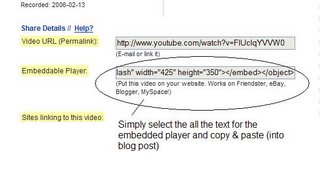 Introduction
IntroductionWithin the past year online video hosting sites have exploded allowing users to easily to upload and share videos on the web. Among all the web 2.0 players in this area, YouTube is currently top dog, coming in at #4 on the list of most visited sites in the US and allowing users not only to upload their own video content easily, but also embed clips into their own sites easily.
Do some searching around YouTube yourself and see what the site has to offer. You'll find everything from 1970s TV commercials and 60s music videos to library dominos and a video of 200 people freezing in place in Grand Central Station. You can even see school administrators doing a parody of a Nextel commercial.
As you explore YouTube and its educator-friendly companion, TeacherTube, you will encounter many familiar Web 2.0 features, such as RSS feeds, user comments/ratings, groups, and, of course, tags. Like many resource-rich websites, much of the content on YouTube is not school appropriate. The comments are unfiltered, so even a perfectly benign and educational video can have reams of inane text posted below it. But there is also a vast wealth of "good" stuff there as well, so it's definitely worth a look. (Plus, now that you know how to EMBED, you can present JUST the video content you choose to students, without visiting the YouTube site directly!)
Of course, like any free site you’ll also find a lot stuff not worth watching too. But that doesn’t mean you shouldn’t explore and see for yourself what the site has too offer. :)
If you're interested, here's a four minute video detailing the History of YouTube...
If you're not, move on to the Discovery Exercise!
Discovery Exercise:
PART 1: YouTube Scavenger Hunt
Have a little look around YouTube. You may want to set a timer, or you'll be posting angry blogs about losing hours of your life. Try tagging your video discoveries to your delicious account for easy reference!!
Your challenge is to find four videos:
- Find two videos that relate to your teaching content and/or professional learning interests.
- Find one video that teaches you "how to" do something. (Will Richardson recently told us that you can find out how to do anything technological by searching YouTube!)
- Find one video that's just fun, nostalgic or interesting to you.
Search tips:
- Enter one or more keywords into the YouTube search tool to find videos having those terms in their titles, tags and descriptions.
- Check out your results and preview some videos. Also check out related videos.
- Click "more" next to a video description to view its tags. Click a tag to see more videos tagged as such.
- Try the advanced search tool to narrow your search results.
- Set "safe" search to filter out "adult" content:

PART 2: Explore TeacherTube (YouTube "alternative" for Education)
TeacherTube, launched in March 2007, aims to provide a "more educationally focused, safe venue for teachers, schools, and home learners" to share instructional videos and student media projects. TeacherTube currently offers free unlimited uploading of educational video. TeacherTube relies on its user community to keep the site student-safe by flagging inappropriate content.
Additional Resources
- Educause: 7 things you should know about YouTube
- Education World: Using YouTube in the Classroom
- Spiral Notebook Blog: A Teacher's Tour of YouTube
Learning Activity
Write a blog post sharing your YouTube and TeacherTube findings. Tell about the videos you discovered and share ideas you have for using video to support classroom or professional learning.
Embed one of your discovered YouTube or TeacherTube videos in your blog. (Feel free to embed a video into your wiki sandbox page as well if you want to experiment).

Include "Thing 18" in your post title.
NOTE: Videos, like music downloads, are bandwidth hogs. It is recommended that you complete this exercise during light internet usage times.


No comments:
Post a Comment